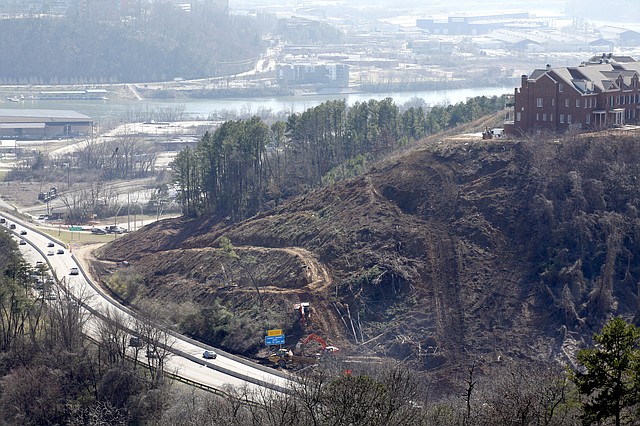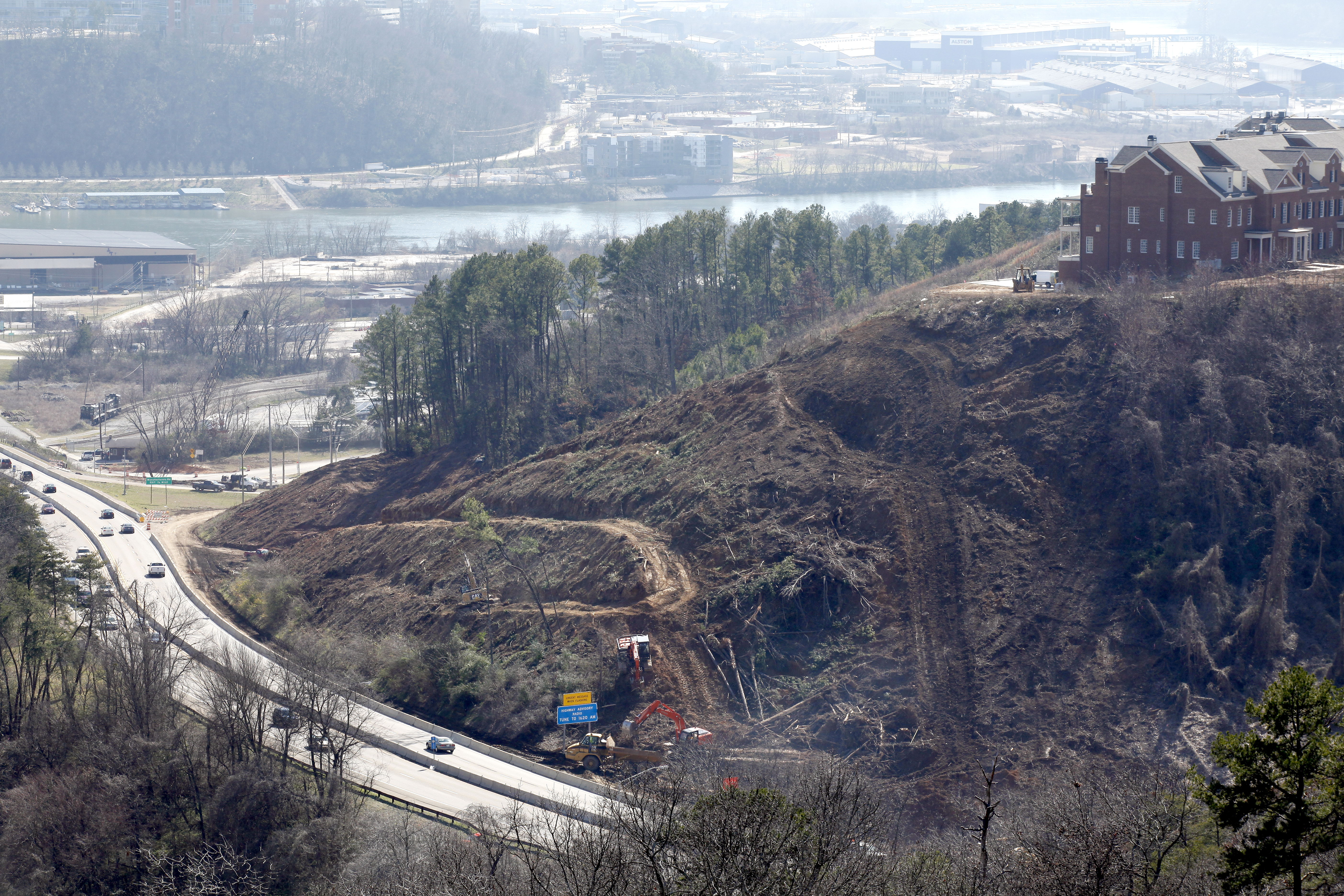Stringer's Ridge adds challenge to U.S. Highway 27 construction
Saturday, February 25, 2012
BY THE BIG NUMBERS• 600,000 cubic yards of excavation• 275,000 tons of large graded rock• 57,000 cubic yards of concrete• 80,000 tons of hot mix asphalt• 6 new bridges• 14,000 linear feet of retaining walls, the longest of which is more than 1,000 feet• 12 miles of steel for the retaining walls• 8 miles of steel for the bridges• Almost 2 miles of concrete drainage pipe• 6 large overhead signs spanning the roadway• 44 roadway lights, 20 are 100 feet tallSource: Tennessee Department of Transportation
When roadwork to widen U.S. Highway 27 between the Olgiati Bridge and the Signal Mountain exit is done, the new stretch could be dubbed the "hundred-million-dollar" mile.
The 1.6-mile passage through narrow breaks in the folds of Stringer's Ridge is budgeted to cost $102.5 million and probably will go over that budget, according to Ken Flynn, the regional construction manager for the Tennessee Department of Transportation.
Because the now four-lane road is in a valley between unstable hills lined with condos, widening it to six lanes and adding adequate acceleration and deceleration space for three sets of on- and off-ramps means moving up the ridge on both sides.
"It's a big challenge," said Flynn. "There's a lot going on in not a lot of space. And there are complications."
TDOT and road contractors must build 31 retaining walls, most of them specialty - read: costly - walls.
In the process of widening the four lanes to six, they also must tear out 10 bridges and build six new ones.
The work isn't scheduled to be complete until October 2014.
Roadworkers plan to keep traffic open on the road the whole time, gradually moving drivers from lane to lane while working in very tight spaces as an estimated 72,000 cars whiz past daily.
The existing road was built decades ago for about 20,000 cars a day, Flynn said.
COMPLICATIONS
The Stringer's Ridge project is just one of three portions of the U.S. 27 widening plan that will affect the Olgiati Bridge and straighten the S curves leading north to the bridge from Interstate 24.
But Stringer's Ridge is a portion with potential complications from every angle.
That's why the estimated $102.5 million cost "is the second or third most-expensive project in the state," said Flynn.
In the 24-county region where he works, Flynn is juggling 175 road projects with $500 million of work under contract.
Many of the steep Stringer's slopes on either side of U.S. 27 are not very stable, according to TDOT testing and previous experience. Some have slid down several times in past decades, and new homes and condos along the ridge lines may be adding pressure.
The buildings also add a different kind of pressure to roadbuilding. State workers don't want to create anything that causes those structures or their private retaining walls to shift. So the state's retaining walls will not be your grandfather's retaining walls. They will have metal pins and cables sunk deep into the slopes - a method TDOT has used before in the Ocoee River Gorge and other rockslide-prone areas.
There's also the distinct possibility of hitting Chattanooga shale, a black, acid-bearing rock that contains pyrite. When exposed to air and water, the rock can produce sulfuric acid and radon. That has happened once in the same section of road.
In 2005, road crews reworking the Signal Mountain Road entrance ramp uncovered a room-sized pocket of the rock, requiring a $408,000 cap. The find bumped the cost of the ramp from $2.2 million to $2.6 million.
If they hit pyrite again, they will have to remove or cap it.
Beneath the Dayton Boulevard on-ramp, the state may have to schedule round-the-clock intensive work to use a crane around a high-voltage TVA power transmission line. In the incredibly tight space between the power tower and the ramp bridge, a crane or equipment swinging too close could cause an arc of massive electricity.
Flynn said the state is working with the Tennessee Valley Authority to reroute temporarily the electricity so power at the tower can be shut off. During the reroute, the state must work quickly, he said.
The ramps on Whitehall Road will be eliminated because they cannot be replaced in a way that brings them to today's state guidelines for acceleration and deceleration lengths, Flynn said.
"They're just too dangerous as they are," he said.
LOCAL IMPACTS
Residents are looking at nearly three years of orange barrels, dust, noise and periods of crawling traffic.
Already, police are blue-lighting drivers for failing to slow down through the now 45-mph construction zone.
Kathy O'Brien's new home juts above the steep Stringer's Ridge slope, recently denuded of trees and kudzu to make way for terraces and retaining walls. She said the work has pluses and minuses.
"They've made our view better," she said, standing at the front door of her Whitehall Road home, "but the noise and construction trucks are kind of bothersome, and we don't like that our exit is closed."
The price for Whitehall's string of new homes and the RiverPoint condominiums has ranged from about $400,000 to nearly $700,000. They all have beautiful views of downtown Chattanooga - and now a front seat to highway construction.
One home's side garden is even in the TDOT retaining wall right of way, according to road workers. Neither that homeowner nor the developer, Jim Morrison, responded to requests for comment.
TDOT's plan to widen the road has been in place for years, Flynn said, and developers knew about it when they built the high-dollar homes on the ridge.
O'Brien, who moved into her home in July, said no one with the state has contacted her, and she would love to know what the retaining walls are going to look like.
"All we know is what we've read in the paper," she said. "We would have liked some information up front to let us know what to expect."
She said she hopes the retaining walls will be attractive, both so they will not hurt her property values and also so they'll be attractive from Chattanooga and to drivers approaching the city.
"This is a gateway to the city and a view from the city," she said. "We want it to be nice."
Flynn said the walls will have what's known as "ashlar stone finish," similar to the white stone-tile look of the retaining wall alongside the Signal Mountain Road on-ramp.

